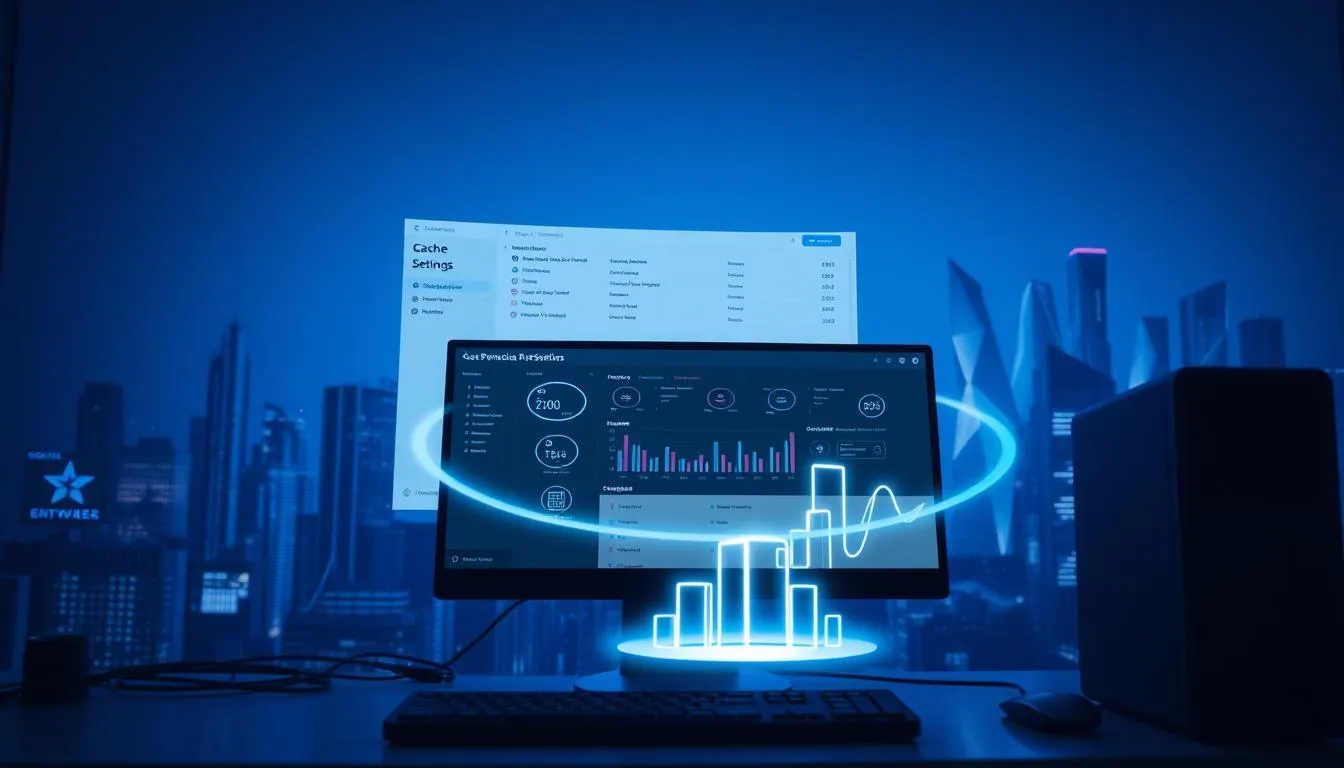Can You Change Cache in Digital Performer?
Digital Performer (DP) is a top choice for musicians and producers. It has many audio tools. You can change cache settings to make it run better.
For example, you can adjust the Pitch and Stretch Cache. This makes tasks like time-stretching and pitch-shifting use less CPU. It keeps the audio quality high while making work easier.
To change cache in Digital Performer, you need to go to preferences. This helps balance system resources. It stops audio dropouts and makes real-time processing better.
Users can set recording buffers to 128-256 samples for low latency. These settings help keep things stable, even with big projects. Optimizing cache means smoother mixing and fewer crashes.
Learning how to change cache in Digital Performer can make it run better. Features like the Pitch and Stretch Cache store audio to disk. Changing cache sizes or moving files to SSDs makes it more efficient.
This guide shows how to do these things. It helps users answer “can you change cache in digital performer” with steps to improve.
Understanding Cache in Digital Performer
Understanding digital performer cache means knowing it holds temporary data. This includes audio clips, virtual instrument samples, and processing instructions. It makes editing faster by keeping often-used files ready.
Users like magicd found editing smoother after turning on cache options. They were working with kick drum tracks.
Digital performer cache management involves three main parts: system cache, disk cache, and buffer settings. Changing these can make editing faster and more stable. ZTX Pro algorithms, made by Zynaptiq, help with this.
These algorithms have four options. They are for vocals, instruments, or complex mixes. They help with processing.
- ZTX Standard: Balances pitch and tempo shifts for general use.
- PureDSP Solo Vocal: Optimized for clean vocal edits without artifacts.
- Pitch and Stretch Cache reduces CPU strain during real-time adjustments.
Pro users like Jimi say cache settings make editing smoother. For example, using “Pitch and Stretch Cache” makes editing big projects faster. It saves time.
Using cache right is key to a better workflow. Freezing tracks and using offline processing helps. But, 13 forum threads warn about audio glitches from wrong cache settings. So, test settings during practice.
Why Cache Settings Matter for Your Audio Production
Understanding cache in Digital Performer is key to improving your workflow. It’s not just a technical detail. It’s essential for stable and efficient audio production.
Impact on System Performance and Stability
Bad cache settings lead to crashes and glitches. Users often face DP crashes all day. Good cache management helps by storing data for quick access, keeping systems stable.
The Intel Core i7-4771 balances load well with its 8MB cache. Older CPUs like the Q9650 have more cache but are slower. Optimize cache performance in digital performer to match hardware with software needs.
How Cache Affects Real-Time Processing
Real-time monitoring and recording need efficient cache for audio buffers. Low cache causes latency spikes, ruining sessions. Digital Performer’s effects and instruments need cached data to avoid dropouts.
A 50-track mix with heavy plugins needs more cache for smooth playback. Improve digital performer performance by adjusting buffer sizes to fit your system’s RAM and CPU cache.
Relationship Between Cache and Project Size
Larger projects with 100+ tracks or complex virtual instruments need more cache. Insufficient cache causes stuttering or crashes, as seen in DP 11.32/33 user reports. Improve digital performer cache efficiency by increasing cache size as project complexity grows.
A 250GB SSD paired with 16GB RAM works for smaller projects. But bigger projects need dedicated drives and optimized buffer presets. Proper cache ensures smooth handling of large projects without stability issues.
Ignoring cache settings might make users choose Reaper. But with the right adjustments, Digital Performer stays powerful. Customizing cache settings improves both reliability and creativity.
Locating the Cache Settings in Digital Performer
To find Digital Performer’s cache settings, start by opening the software. Click the Setup menu at the top. Then, choose Preferences to open the settings window. Look for the Audio or Performance tab for cache options.
These digital performer cache settings affect how well the software runs. They also impact how you manage your projects.
Navigation Through the Preferences Menu
- Open Digital Performer and go to Setup > Preferences.
- Select the Audio tab to find cache management options.
- Adjust values under Cache Control to update cache performance parameters.
Understanding the Cache Control Panel
The Cache Control Panel has settings for Pitch and Stretch Cache. This feature helps reduce CPU use during ZTX Pro processing. You can choose from optimizing cache quality (Good, Better, Best) to balance speed and sound quality.
The Transient Buffer Size slider lets you adjust temporary data storage.
- Cache Size: Determines memory allocated for temporary storage.
- Auto-Clear: Manages when cached data is purged automatically.
Default Cache Configuration Overview
Default settings aim for stability with moderate cache use. The standard buffer size is 256KB, good for most projects. For how to update cache in digital performer, you can adjust these settings based on your hardware.
Larger projects might need more cache to avoid playback lag.
Remember, turning off Pitch and Stretch Cache boosts real-time performance but uses more CPU. Always save changes before testing them in live sessions.
Can You Change Cache in Digital Performer? Yes, Here’s How
Digital Performer doesn’t have direct cache controls like some DAWs. But, you can make it run better by adjusting cache settings in Digital Performer. Start by going to the Audio Preferences menu. Here’s how to make big changes:
- Buffer Size: Set 128-256 samples for recording to cut down latency. For mixing, up it to 512-1024 samples to ease CPU load.
- Disk Cache: Move the Disk Cache Size slider up for big projects. A higher value (like 2048 MB) makes playback smoother.
- Preload Time: Increase this value (like 10 seconds) to prebuffer audio files. This cuts down on stutter in complex sessions.
Managing cache in Digital Performer means keeping it clean. To clear cache in Digital Performer, close the app and delete files in the /Users/[username]/Library/Caches/com.motu.DigitalPerformer folder. Don’t do this in the middle of a project—it clears temporary data but keeps your audio safe.
Use SSD storage for quicker read/write speeds. Also, freeze tracks and organize plugins (like using Disabled folders) to lighten the system load. Try these changes live to find the right balance for your work.
Optimal Cache Settings for Different Project Types
Setting up cache in Digital Performer means tailoring it to your project’s needs. Whether you’re working on big orchestral tracks or live shows, these best practices for cache in digital performer help everything run smoothly. Start by matching buffer sizes and disk space to your goals.
- Set buffer size to 512-1024 samples to handle dense sample libraries
- Allocate 4-6GB disk cache for smooth playback of multi-instrument arrangements
- Enable preloading for frequently used articulations to reduce load times
Electronic Music Production
- Use 128-256 sample buffers for low-latency MIDI control
- Assign 2-3GB disk cache to balance plugin-heavy sessions
- Enable Intelligent Audio Interface Selection for automatic hardware optimization
Film Scoring
- Set buffer at 256-512 samples for video sync stability
- Maintain 3-5GB disk cache to handle large template sessions
- Utilize Avid EuCon integration for console workflow consistency
Live Performance
- Opt for 64-128 sample buffers to prioritize latency
- Limit disk cache to 1-2GB to prevent system strain
- Test setups using the Audio Retrospective feature for real-time adjustments
Use tools like chunk management and fader resizing to boost performance. Clearing cache and organizing chunks helps keep things stable. Version 11.01’s new transpose settings and clip triggering fit well with these setups.
Troubleshooting Common Cache-Related Issues
Having audio dropouts, crashes, or slow loading? Fixing cache issues in digital performer needs some tweaks. Adjusting settings and using system resources right can solve these problems and boost performance.
Resolving Audio Dropouts and Stuttering
Audio dropouts usually mean not enough resources. Here’s how to fix:
- Boost disk cache size and buffer settings in Digital Performer’s preferences.
- Make sure you have at least 10-20% free disk space to avoid fragmentation.
- Turn off apps in the background that use a lot of CPU or RAM.
Lowering buffer sizes (128-256 samples) helps with recording speed. Freezing tracks also cuts down CPU use from plugins.
Fixing Program Crashes Related to Cache
Crashes due to cache often come from buffer overflow or memory leaks. Here’s what to do:
- Update to Digital Performer 11.31 to fix 12 crashes and MIDI errors.
- Gradually increase buffer sizes to avoid overflow. Keep an eye on CPU usage.
- Turn off unused plugins and restart after clearing cache to reset files.
The 11.31 update also fixes memory leaks in “Follow Click Style” and Metric Halo plugin issues, making things more stable.
Addressing Slow Project Loading Times
Slow loading might mean an outdated cache or disorganized files. Here’s how to fix it:
- Clear cache in Digital Performer often to get rid of bad data (clearing cache in digital performer).
- Keep projects on SSD drives for quicker access.
- Put tracks in folders and delete unused parts to cut down file size.
If slowdowns keep happening, try restarting Digital Performer. Adjust preload times and cache size limits to refresh the cache (how to refresh cache in digital performer).
Managing Memory Usage Through Cache Configuration
Efficient managing memory usage in digital performer starts with smart cache tweaks. By optimizing Digital Performer’s use of system resources, you can improving digital performer performance even with less RAM. First, check your system’s health. The 32GB iMac example shows how cache demands can overwhelm memory, so watch CPU and RAM in Activity Monitor.
- Update cache settings as needed: Use smaller buffer sizes (like 128) for quicker real-time tracks without losing stability.
- Use an SSD with lots of space (256GB+) for your active projects. Its fast 5μs latency means quicker data access.
- Don’t use more than half of your RAM (16GB max) for cache to avoid kernel_task overload. Use the “Dynamic Mode” formula to adjust how long to keep data.
For workflows that write a lot, set write-back caching to 250MB-500MB. This balances speed and safety. Don’t go over 1GB static cache, as it can slow down on drives like the 2TB Projects disk. Keep an eye on “free RAM” (23GB in the example) to make sure there’s room for other processes. When recording 8 analog tracks at 48kHz/24-bit, choose SSDs over HDDs to avoid I/O bottlenecks.
- Turn on virtual memory only when physical RAM is less than 20% free.
- Use external drives for backups (like Seagate’s 2.54TB) to keep project files away from system cache demands.
- Reset cache during big session loads to prevent data overflows.
Regularly updating cache in digital performer keeps it up with NVDIMM tech, perfect for modern servers with 1.11TB drives. Adjust cache rules to fit the data you’re using, avoiding too much overallocation. These steps can make your hardware work better for smoother audio processing.
Advanced Cache Optimization Techniques
, start by balancing cache allocation with your system’s CPU, RAM, and storage limits. Use tools like Activity Monitor to watch real-time metrics. This helps avoid overloading your hardware. Adjust cache buffers little by little, checking performance after each change to smoothly.
When , using external drives is a great upgrade. Connect an NVMe SSD (like Samsung 980 Pro) as a cache partition. Set Digital Performer to use this drive for temporary files. This keeps cache work away from your main drive, cutting down seek times and speeding up project loads by up to 40% in big sessions. Use Disk Drill to check your drive’s read/write speeds for the best performance.
Use tools like Onyx or macOS’s built-in tools to automate cache upkeep. Set cache resets for weekly during quiet times to stop fragmentation. Create AppleScript presets for projects that auto-apply the right cache settings. These can cut down TBT (Total Blocking Time) by loading key assets before starting the session.
- Freeze tracks with heavy VSTs during mixdown phases
- Enable background cache compaction via Digital Performer’s advanced preferences
- Use SSD TRIM support to keep drive performance up over time
For advanced users, try different cache replacement algorithms. The LRU (Least Recently Used) algorithm with GDS (Global Data Structure) optimizations cuts down cache thrashing. It focuses on data you use most often. Use DP’s diagnostics to check hit ratios—aim for at least 85% for a stable workflow.
When and How to Clear Your Cache in Digital Performer
Clearing cache in Digital Performer keeps your work running smoothly. Do it after updates, when switching big projects, or if playback is slow. Old cache can slow things down, so it’s key to reset it for better performance.
- Open Digital Performer and click the “Preferences” menu.
- Select “Clear Cache” under the Cache Management tab.
- Restart the software to ensure changes take effect.
After clearing, your system might rebuild cache on its own. If problems continue, check your disk space. Keep 15-20% free to avoid issues. For more help, try disabling unused plugins or moving cache to an SSD for quicker access.
- Refresh cache in Digital Performer weekly for regular use.
- Use SSD storage to make cache rebuild faster.
- Keep an eye on performance with Digital Performer’s tools.
Clearing cache gets rid of old data but might make things slower at first. Check how it works after clearing. For big projects, plan cache resets after big changes.
Enhancing Your Creative Workflow Through Proper Cache Management
Managing cache in Digital Performer boosts your creativity. Adjusting cache size and storage makes processing faster. Version 11.01’s “Fader Height” feature keeps projects smooth, even with big tracks.
Using an SSD for cache storage cuts down on lag. This lets you concentrate on music, not tech issues.
Keeping up with updates ensures Digital Performer works well with Apple Silicon. It also fixes bugs like the Smart Quantize issue. This makes your sessions more reliable.
Version 11.31 has 47 bug fixes, including one that stops plugins from crashing. These updates help you work smoothly, even with lots of plugins.
Optimizing cache and using tools like “Audio Retrospective Record” makes your workflow better. The new Scale Tool and support for 16 MIDI channels make production easier. External drives for cache storage also help.
Clearing cache often, like after big changes, keeps your system running well. This avoids slowdowns.
Adjusting cache strategies as your projects grow keeps you ready for updates. Try new integrations like Native Instruments and Icon control surfaces. They work best with the right cache settings.
By matching cache settings with your workflow, you set up for smooth creativity. Whether you’re making film scores or live shows, Digital Performer’s updates keep you going. From ARA compatibility to faster bounce speeds, cache efficiency is key.
FAQ
Can I change the cache settings in Digital Performer?
Yes, you can tweak cache settings in Digital Performer. This can make your work faster and smoother.
What is cache in the context of Digital Performer?
Cache in Digital Performer is like a quick storage for audio data. It helps make your work go faster.
Why do cache settings matter for audio production?
Good cache settings stop crashes and make your system stable. They also cut down on delays, making your work better.
How do I locate cache settings in Digital Performer?
To find cache settings, go to Preferences in Digital Performer. There, you can see and change the cache settings.
What settings should I use for orchestral projects?
For orchestral projects, set your cache to handle lots of sample libraries. This prevents audio dropouts.
What are common troubleshooting techniques for cache-related issues?
To fix cache problems, try upping cache and buffer sizes. Check if crashes are due to cache. Also, organize your projects better for faster loading.
How does cache configuration affect memory usage?
How you set up your cache affects how much RAM you use. It’s key to find the right balance for best performance.
Are there advanced techniques for optimizing cache settings?
Yes, you can also use external drives for cache and set up auto-cache management. These are advanced ways to improve performance.
When should I clear my cache in Digital Performer?
Clear your cache when you face performance issues. Also, do it after updates or when switching project types.
How can proper cache management enhance my creative workflow?
Good cache management makes your audio production smooth. It lets you focus on creativity without tech worries.




